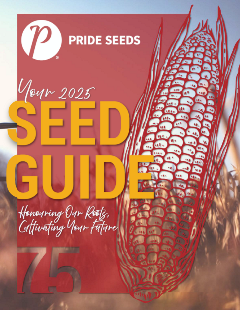Browse our selection of products below
___________________________________________________________________________________________________________________________________________

2024-2025 PRIDE Seeds Product GuideYou can find all of our products on the website, including supporting performance data and create your own personalized guide called My Guide. You can also download the digital version of our printed product guide which includes product comparison charts. |
Enhance your knowledge and stay ahead with PRIDE SEEDS Corn and Soybean School videos.
SHOP THE PRIDE SEEDS E-STORE
-7.png?sfvrsn=87920db3_3)
STAY UP-TO-DATE WITH PRIDE SEEDS LATEST BLOGS, NEWS AND ARTICLES
Soybean Sudden Death Syndrome (SDS)
Sudden Death Syndrome (SDS) is a disease in soybeans that has been prominent in the US Mid-West for many years, but is now becoming more prevalent in Ontario.
SDS symptoms will start to show up in a soybean from bloom to pod fill, but is most commonly seen between R3 to R6. The symptoms to identify SDS are light green spots on the leaf surface between the leaf vein and will generally show up partway up the canopy of the plant.
These spots will then turn yellow and then brown as the leaf tissue dies. The areas of the field that will generally show these symptoms first are the wet, or poorly drained areas. They can show up on a single plant or in oval areas in the field. SDS is caused by Fusarium Solani which is found in most soils and will affect the plant's lateral roots.
What causes the disease to infect the plant could be many things from Cyst, to other root diseases, and weather events. Fusarium Solani will infect the plant early in the season but symptoms can't be seen until later as stated above (commonly R3 to R6). When the plant shows symptoms it will eventually lose all the leaves, but the leaf petioles stay on the plant. These infected plants will not have any soybeans on it at harvest.
What are best ways to prevent/avoid getting SDS in your soybeans?
The best management practices include:
- Improved Drainage- keeping the roots healthy
- Rotating Crops- help to manage SCN in the field
- Tillage- crop residue carries more disease
- Variety Selection- Choosing SCN resistant varieties as well as reviewing for SDS ratings.
As well, when evaluating for SDS in a soybean field, Brown Stem Rot (BSR) looks very similar. Here are the differences to help:
- BSR causes browning of the pith (inside of the stem), SDS doesn't
- BSR does not cause root decay (root dead and rotting), SDS does
- BSR shows up even later in the season than SDS (R5-R6).
For more information and assistance, contact your local PRIDE Seeds Agronomy team member.
TAKE PRIDE IN YOUR INBOX
Expert advice, news and information
THE PRIDE SEEDS ADVANTAGE
Farming is one of the most demanding industries in the world, subject to a variety of factors such as time, weather, and global pressures. You know this every time you look out the window and think about the field in front of you. Growers and dealers deserve an advantage: The PRIDE Seed Advantage.
LEARN MORETHE PRIDE SEEDS ADVANTAGE
Every year PRIDE Seeds works hard to produce leading-edge products that enable success where it matters most, on your farm. Our dedicated team strives to provide sales expertise, agronomy support, quality production, and service tailored to meet your needs.
LEARN MORE

Leave a commentOrder by
Newest on top Oldest on top